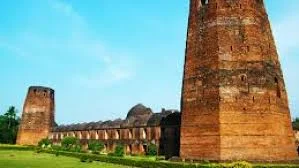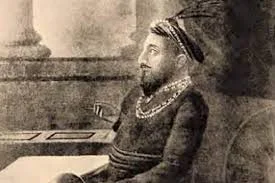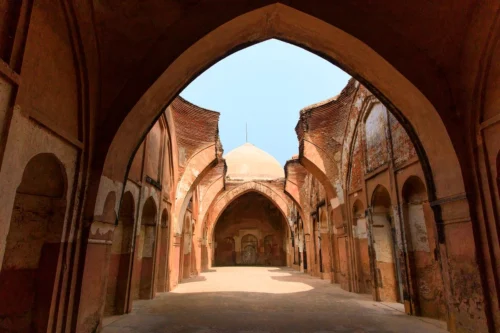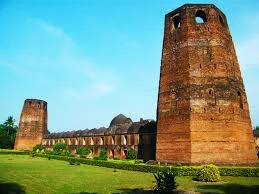Introduction

Katra Masjid—also known as Katra Mosque or “Market Mosque”—is located on the northeast side of Murshidabad, West Bengal. The construction of this huge monumental complex was ordered by Nawab Murshid Quli Khan in 1723-24 CE to be used as a mosque, tombs, a caravanserai, and centers of Islamic learning. It has a raised square plinth of approximately 54 m × 54 m, which consisted of a large space for housing religious students and travelers; thus, it became one of the largest caravanserais in the Indian subcontinent with space for accommodating 700 Quran-readers and about 2,000 worshippers in its courtyard.
History

The period of 1723-24 saw Katra Masjid being built by Nawab Murshid Quli Khan, the very first independent Nawab of Bengal, and the founder of Murshidabad. He originally was Surya Narayan Mishra, born in the Deccan, later enslaved, converted to Islam, and rose through the ranks of the Mughal administration. Appointed Diwan and later Subahdar of Bengal by Emperor Farrukhsiyar in 1717, Murshid Quli Khan moved the seat from Dhaka to Murshidabad, making it politically and economically very vibrant.
It is said to have had all the features concerning a place of religious worship, learning, and trade, being a mosque, madrasa, and caravanserai. This was the symbolic expression of his devotion and authority. Before his death in 1727, he had requested to be buried under the eastern stairway of the mosque, so that visitors would walk over his grave as an act of profound humility.
It had remained active during the Nawabi time but lost its significance after the Battle of Plassey in 1757 and British supremacy. A major earthquake took off a couple of its domes and minarets in 1897. It has been maintained as a protected monument under the Archaeological Survey of India since 1910, exemplifying a relevant relic pertaining to Bengal’s early modern Islamic and architectural heritage.
Architectural Design
Layout & Structural Design

The mosque is built on a high brick platform of about 54 m on each side, supporting a vast courtyard flanked by double-storied domed cells that were originally used for Quranic students or traders. These cells enclose a continuous colonnade around the central open space, with entry via a flight of 14 stairs on the east, above which lies the crypt of Murshid Quli Khan.
The prayer hall is a single-aisled, five-bay structure with each bay being surmounted by a dome. The roof was originally crowned by five domes, among which three are now left–arranged in a linear axis over the bays. It is sometimes referred to as the largest Mughal-style mosque in Bengal, although largely in ruins now.
Domes and Drums

To make an octagonal base for the dome, a spherical bulbous dome has been conceived. These drums have ornamental lotus petal motifs that travel through all mosque architecture in Murshidabad. The pinnacle of the domes, too, is lotus-shaped. Some scholars have stated that the lotus symbolism is more of a regional decorative habit than any religious statement or an interpretation of a myth.
Minarets and Defensive Features

These four octagonal minarets were formerly situated on each side of the four corners of a square construction. They rise higher than 70 feet, tapering at the top. Each minaret has an internal winding staircase that is mostly closed to the public but leads to the top section, providing an excellent view of the city. Also present in these minarets, a series of loopholes for muskets, indicating that historically they would be used defensively or at least symbolically battle-ready. In 1897, these minarets fell: two survived, now ruined but imposing.
Arches, Facade & Ornamentation
The superior elevation seems to present an open facade of the aperture lined by a series of cusped arches, sometimes having their attachment with the nepenthes. The rounded cusped arches could probably be indicative of the European influence mingled with the traces of the Mughal-Sultanate parentage. The sides of the entrance arch and the drums’ flat-surfaces were framed into squares of lotus petal ornamentation, while insides and spandrels were loaded with arabesques, floral designs, and Persian phrases that extolled the Prophet Muhammad. Dust be on the head of him who is not the dust of his portal.” Surface (plaster) stucco and tile work would have enhanced the details, but erosion has perished much of it, and now faded traces memorialize its richness.
Motifs and Decorative Elements

Lotus Motifs
The lotus petal pattern, a stunning motif, adorns the octagonal drum bands beneath the domes and pilaster panels. Seen on many of the nobly built mosques of Murshidabad, this emblem of purity and resilience became a defining trait in the mosque architecture of the early 18th century. Some local guides misinterpret it as a symbol of repentance or syncretism with Hindu symbols-but architectural historians stress that the lotus motif was a traditional aesthetic choice in Bengal’s Islamic architecture and not an apology for Hindus.
Arches & Entrance Bays
The main entryway has three cusped arches, the recessed arches engaged within tackle columns, and riches of cartouche-style ornamentation. The surrounding arches and mihrabs are bejeweled with decorated bands of vaulted motifs, fan motifs or taziya-shaped designs are very off-sweet blend of late Sultanate patterns and early Mughal invention.
Inscriptions
Two Persian inscriptions survive: one above the entrance proclaiming the mosque’s spiritual dedication, the other crediting Murshid Quli Khan as its founder. Both panels are stone or tile-embedded and give credence to the historical record of the mosque.
Current Status

Presently, the Katra Masjid is protected by the ASI (since 1910) and is classified as a Monument of National Importance, with ownership vested in the Government of West Bengal. Presently, it is not used for regular worship, although visitors may freely visit the site (without any entry charge), mostly between morning and evening hours. A fair number of locals also visit, and tourist accounts consider the mosque an arresting historical site and an example of elegant architecture, though they complain about the absence of basic infrastructure and facilities for interpretation.
Some tourists have described the persistent presence of local guides at the entrance, offering narratives guided by mythology (temple destruction stories, dramatic family tragedies), despite architectural scholars cautioning against such dubious claims.
Conclusion
Katra Masjid stands as a majestic witness to the early Nawabi era—a time when Murshid Quli Khan established Murshidabad as a political, commercial, and religious capital. As both his tomb and a hub for Islamic education, the mosque embodied spiritual humility, civic ambition, and Mughal grandeur. Its architectural style skilfully fuses classic Mughal planning—with its domes, arches, and emphasis on symmetry—with regional Bengali motifs, especially the lotus-ornament echo in dome drums and facade panels. The robust octagonal minarets, armed with loopholes, hint at defensive or symbolic power, while the high plinth and madrasah‑cells reflect both practical design and educational intent.
Despite suffering damage from the 1897 quake, the mosque’s surviving forms—its domes, minaret bases, arches, inscriptions, and courtyard—still narrate a story of refinement, faith, and resilience. As a protected heritage site, it invites continued appreciation and sensitive preservation.
References:
1.https://amitabhagupta.wordpress.com/2015/03/11/history-revisited-at-murshidabad/
2.https://www.indianetzone.com/katra_mosque
3.https://sritiochetona.org/occupied-mandirs-exhibit-3-katra-masjid/
4.https://youngintach.org/files/katra-masjid.pdf
5.https://www.exploreourindia.com/katra-masjid
6.https://www.atlasobscura.com/places/katra-masjid




